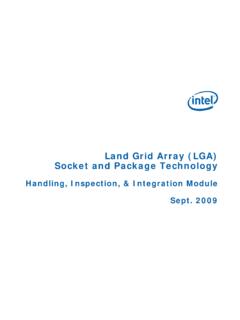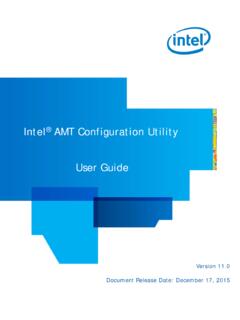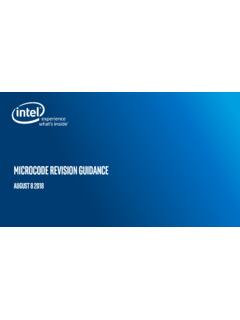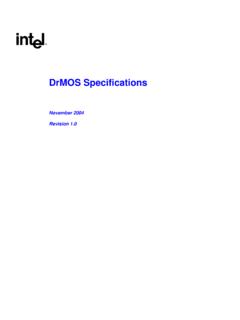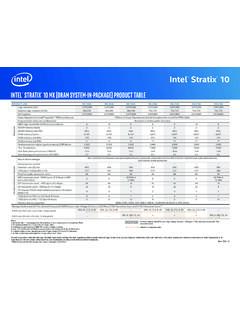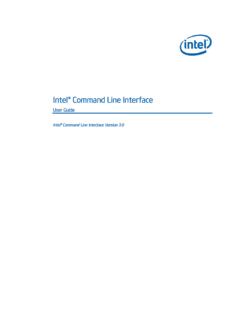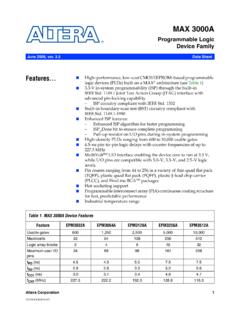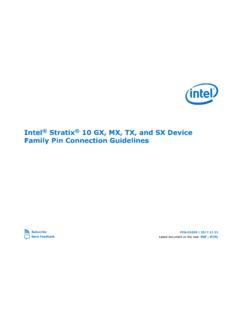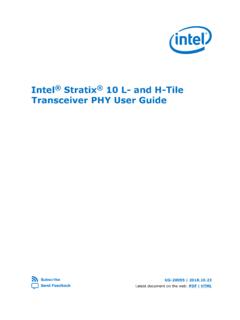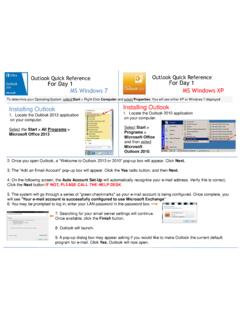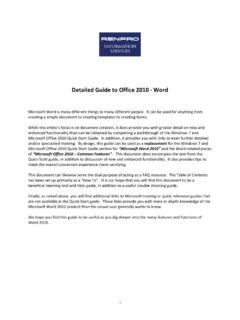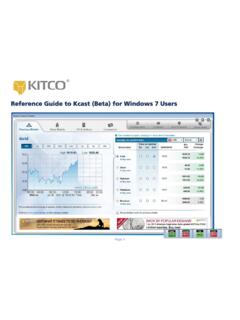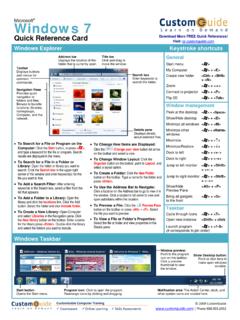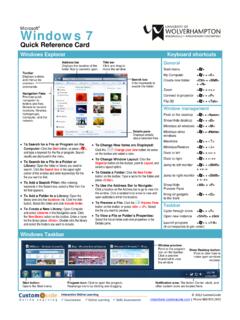Transcription of Trusted Platform Module (TPM) Quick Reference Guide
1 Trusted Platform Module (TPM) Quick Reference Guide System builders/integrators should give this Guide to the system owners to assist them in enabling and activating the Trusted Platform Module . Trusted Platform Module (TPM) Quick Reference Warning of Potential Data Loss ..3 Trusted Platform Module (TPM) ..4 System Requirements ..4 Security Precautions ..4 Password Procedures ..5 Emergency Recovery File Backup Hard Drive Image Backup Clear Text Backup (Optional) ..6 Trusted Platform Module Ownership ..7 Trusted Platform Module Software Enabling the Trusted Platform Module ..7 Assuming Trusted Platform Module Recovery Procedures ..9 How to Recover from a Hard Drive Failure ..9 How to Recover from a Desktop Board or TPM Clearing Trusted Platform Module Ownership ..10 Support Links ..11 2 Trusted Platform Module (TPM) Quick Reference Guide INFORMATION IN THIS DOCUMENT IS PROVIDED IN CONNECTION WITH INTEL PRODUCTS.
2 NO LICENSE, EXPRESS OR IMPLIED, BY ESTOPPEL OR OTHERWISE, TO ANY INTELLECTUAL PROPERTY RIGHTS IS GRANTED BY THIS DOCUMENT. EXCEPT AS PROVIDED IN INTEL'S TERMS AND CONDITIONS OF SALE FOR SUCH PRODUCTS, INTEL ASSUMES NO LIABILITY WHATSOEVER, AND INTEL DISCLAIMS ANY EXPRESS OR IMPLIED WARRANTY, RELATING TO SALE AND/OR USE OF INTEL PRODUCTS INCLUDING LIABILITY OR WARRANTIES RELATING TO FITNESS FOR A PARTICULAR PURPOSE, MERCHANTABILITY, OR INFRINGEMENT OF ANY PATENT, COPYRIGHT OR OTHER INTELLECTUAL PROPERTY RIGHT. Intel products are not intended for use in medical, life saving, life sustaining applications. Intel may make changes to specifications and product descriptions at any time, without notice. Intel is a trademark of Intel Corporation in the and other countries. *Other names and brands may be claimed as the property of others. Copyright 2009 Intel Corporation Trusted Platform Module (TPM) Quick Reference Guide 3 Warning of Potential Data Loss IMPORTANT USER INFORMATION.
3 READ AND FOLLOW THESE INSTRUCTIONS PRIOR TO Trusted Platform Module INITIALIZATION. System integrators, owners, and end users must take precautions to mitigate the chance of data loss. Data encrypted by any program utilizing the Trusted Platform Module (TPM) may become inaccessible or unrecoverable if any of the following occurs: Lost Password: Loss of any of the passwords associated with the TPM will render encrypted data inaccessible. No password recovery is available. Read the Security Precautions for Password Procedures. Hard Drive Failure: In the event of a hard disk (or other storage media) failure that contains encrypted data, an image of the hard disk (or other storage media) must be restored from backup before access to encrypted data may become available. The owner/user should backup the system hard disk on a regular basis. Read the Security Precautions below for Hard Drive Backup Procedures.
4 Platform Failure: In the event of a Platform failure and/or replacement of the desktop board, recovery procedures may allow migratable keys to be recovered and may restore access to encrypted data. All non-migratable keys and their associated data will be lost. The Wave Systems* EMBASSY* Security Center utilizes migratable keys. Please check any other software that accesses the TPM for migratability. Read the Security Precautions for Emergency Recovery File Backup Procedures. Loss of Trusted Platform Module Ownership: Trusted Platform Module Ownership/contents may be cleared (via a BIOS switch) to allow for the transfer of a system to a new owner. If TPM ownership is cleared, either intentionally or in error, recovery procedures may allow the migratable keys to be recovered and may restore access to encrypted data. Read the Security Precautions for Emergency Recovery File Backup Procedures. 4 Trusted Platform Module (TPM) Quick Reference Guide Trusted Platform Module (TPM) The Trusted Platform Module is a component on the desktop board that is specifically designed to enhance Platform security above-and-beyond the capabilities of today s software by providing a protected space for key operations and other security critical tasks.
5 Using both hardware and software, the TPM protects encryption and signature keys at their most vulnerable stages operations when the keys are being used unencrypted in plain-text form. The TPM is specifically designed to shield unencrypted keys and Platform authentication information from software-based attacks. System Requirements Intel Desktop Boards Executive Series Microsoft Windows* XP Professional (SP2), Microsoft Windows Vista*, or Microsoft Windows* 7 operating system NTFS file system Microsoft Internet Explorer or later Adobe* Acrobat* or later Security Precautions Security, like any other aspect of computer maintenance, requires planning. What is unique about security has to do with understanding who "friends" are and who adversaries are. The TPM provides mechanisms to enable the owner/user to protect their information from adversaries. To provide this protection, the TPM effectively puts "locks" around the data.
6 Just like physical locks, if keys or combinations are lost, the assets (data) may be inaccessible not only to adversaries, but also to the asset owner/user. The TPM provides two classes of keys: migratable and non-migratable. Migratable keys are designed to protect data that can be used (unencrypted) on more than one Platform . One advantage is allowing the key data to be replicated (backed up and restored) to another Platform . This may be because of user convenience (someone uses more than one Platform , or the data needs to be available to more than one person operating on different platforms). Another advantage to this type of key is that it can be backed up and restored from a defective Platform onto a new Platform . Trusted Platform Module (TPM) Quick Reference Guide 5 However, migratable keys may not be the appropriate level of protection needed for the application when the user wants the data restricted to a single Platform .
7 This requires a non-migratable key. Non-migratable keys carry with them a usage deficit in that while the key may be backed up and restored (protected from hard disk failure) they are not protected against system or TPM failure. The very nature of a non-migratable key is that they can be used on one and only one TPM. In the event of a system or TPM failure, all non-migratable keys and the data associated with them will be inaccessible and unrecoverable. The following precautions and procedures may assist in recovering from any of the previously listed situations. Failure to implement these security precautions and procedures may result in unrecoverable data loss. Password Procedures The Wave* Systems EMBASSY* Security Center software allows users to configure passwords from 8 to 255 characters. A good password should consist of: At least one upper case letter (A to Z) At least one numerical character (0 to 9) At least one symbol character (!)
8 , @, &, etc.) Example Passwords: I wear a Brown hat 2 worK @ least once-a-month or uJGFak&%)adf35a9m NOTE Avoid using names or dates that can be easily guessed, such as birthdays, anniversaries, family member names, or pet names. All passwords associated with the EMBASSY Security Center (owner, TPM Key Archive, and other archives) are NOT RECOVERABLE and cannot be reset without the original text. The system owner should document all passwords, store them in a secured location (a vault, safe deposit box, or off-site storage), and have them available for future use. These documents should be updated after any password changes are made. 6 Trusted Platform Module (TPM) Quick Reference Guide Emergency Recovery File Backup Procedures Use the EMBASSY Security Center to create the TPM Key Archive file ( ) onto a removable media (a floppy disk, CDR, or flash media). Once this is completed, the removable media should be stored in a secure location.
9 DO NOT LEAVE ANY COPIES of the TPM Key Archive on the hard drive or within any hard drive image backups. If a copy of the TPM Key Archive remains on the system, it could be used to compromise the Trusted Platform Module and Platform . This procedure should be repeated after any password changes or the addition of a new user. Hard Drive Image Backup Procedures To allow for emergency recovery from a hard drive failure, frequent images of the hard drive should be created and stored in a secure location. In the event of a hard drive failure, the latest image can be restored to a new hard drive and access to the encrypted data can be re-established. NOTE All encrypted and unencrypted data that was added after the last image was created will be lost. Clear Text Backup (Optional) It is recommended that system owners follow the Hard Drive Image Backup Procedures. This option is not recommended because the data is exposed during backup and restores.
10 To backup select files without creating a drive image, files can be moved from secured programs or drive letters to an unencrypted directory. The unencrypted (clear text) files may then be backed up to removable media and stored in a secure location. The advantage of the clear text backup is that no TPM key is required to restore the data. Trusted Platform Module (TPM) Quick Reference Guide 7 Trusted Platform Module Ownership The Trusted Platform Module is disabled by default when shipped and the owner/end customer of the system assumes ownership of the TPM. This permits the owner of the system to control initialization of the TPM and create all the passwords associated with the TPM that will be used to protect their keys and data. System builders/integrators may install the Wave Systems EMBASSY Security Center, but SHOULD NOT attempt to use or activate the TPM or the software package. Trusted Platform Module Software Installation The software package for the TPM can be installed from the Intel Express Installer DVD.
